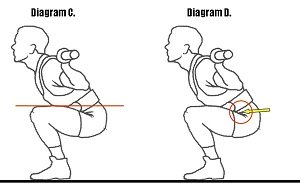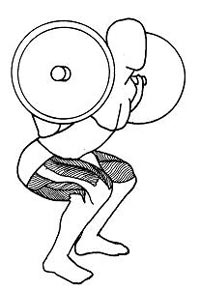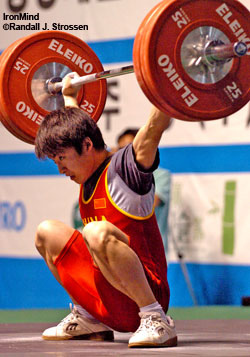Know Your Squat Depth
As much as squat variations are accepted and recommended for trainees, I find quite a few people are confused as to squat depth and aren't really sure what they should be shooting for when it comes to depth.
As I discuss ad nauseum in Vertical Jump Bible 2.0 in my experience there's a big disconnect between what people actually call a squat and what type of squat they actually do. What most people call "full squats" are actually half squats and what most people call half squats are actually quarter squats.
Personally, I usually recommend people do a squat to a legal powerlifting depth, or to a point where the lower back begins to round, whichever comes first. To perform a legal powerlifting depth squat imagine drawing a parallel line across the top of your kneecap. As you squat down the crease where your upper thigh and hip joint together should temporarily break below that line (the top of the knee). Here is a pic to illustrate:

Note how the crease at the hip (the arrow) temporarily breaks below the top of the kneecap. That's a legal squat. The hip crease doesn't have to break FAR below the knee cap, but it should break below it at least a little.
Some people will have problems with their lower back rounding as they descend. Here is a video to illustrate lower back rounding: I was trying to illustrate a bad example with this squat. Notice how my lower back starts to round as I get to around parallel in the first 2 reps:
The usual culprit for this is the upper back and torso are not as vertical as they should be. This can occur due to bad form or upper back tightness. If your lower back tends to round short of legal depth do a front squat and see if the same thing happens. If you can front squat to a legal depth correctly you know you just need to work on keeping your upper back more vertical in the back squat. Work on doing that and incorporate some thoracic mobility work.
However, SOME people can't achieve legal depth without their lower back rounding no matter what they do. Many tall people fit the bill here. These people shouldn't push the issue. Just squat to whatever depth you can while maintaining your natural arch.
The next type of squat I want to discuss is a half squat. In the half squat the top of the thigh will get to parallel. This will be a couple of inches higher than a legal powerlifting squat.

I typically don't recommend half squats except for specific phases where the use of partials can be used to peak out strength. In my experience the average trainee who switches from half squat to legal depth squats will gain a near immediate 2-3 inches of vertical jump increase just by taking their squats thru a fuller range of motion, even with a significant lesser load. As a personal example when I first began training seriously I trained for a good 3-4 years performing half squats because I didn't know any better and half squats are what we were taught in school. When I learned what a legal squat was my poundages went all the way from around 300 down to around 185, BUT despite the significantly lesser weights I started making really good vert gains and gained quite a bit of muscle on my thighs. I've seen the same thing happen in countless other trainees.
The next type of squat is a full squat. This is a true olympic squat. It requires excellent mobility throughout the body.

I don't necessarily recommend full squats but if someone can do them correctly and likes doing them I see no reason not to include them. I just wouldn't consider them necessary and not everyone can do them correctly.
The main point to take home is the principles of legal squat depth apply to all squatting variations: front squats, overhead squats, lunges, bulgarian split squats, leg press, you name it. Know what correct depth is and try to work towards it if you're currently doing something different. Good luck with it!
-Kelly
